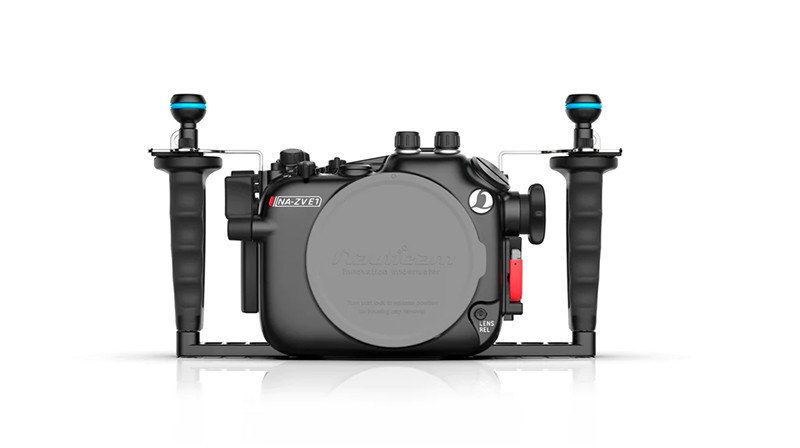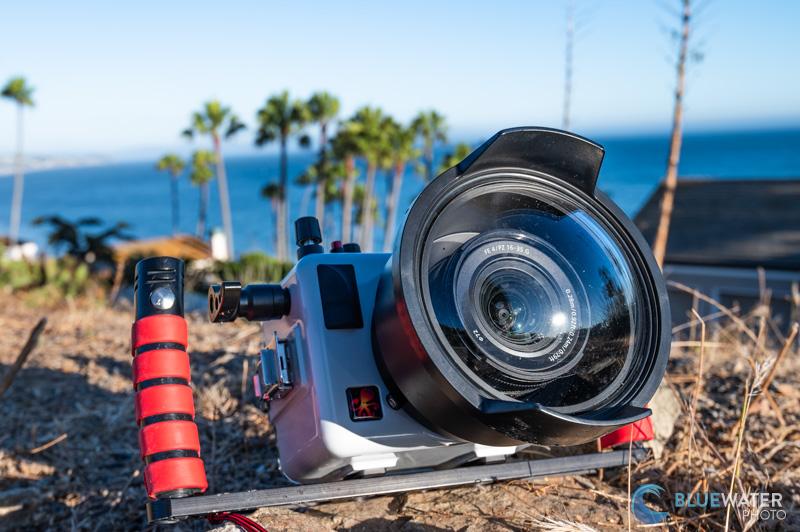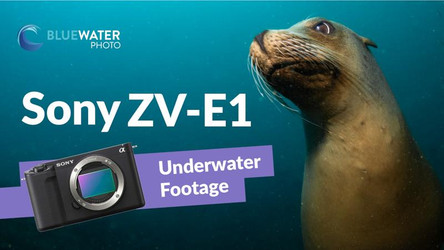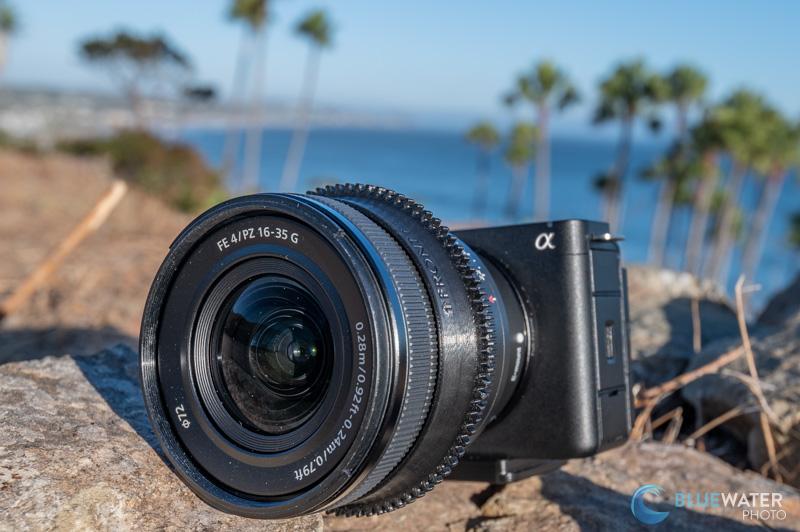Sony ZV-E1 Underwater Review
Posted by Nirupam Nigam on September 29th, 2023

As Sony's smallest ever full-frame camera, the Sony ZV-E1 is an incredible value for underwater video shooters. At $2198 for the body, it offers almost the same feature set as the ever popular Sony A7S III and Sony FX3. This even includes the ability to capture 4K/120p, and many new AI features debuting in this camera. Fortunately, we were able to take the ZV-E1 diving with an Ikelite ZV-E1 housing during our recent Sea of Cortez underwater photography workshop. Although the small form factor can introduce overheating limitations - we made sure to run some tests in our underwater review. So read on to find out if overheating is a deal breaker for underwater shooters or if the ZV-E1 is the dream underwater video camera!
Sony ZV-E1 Key Specifications
- 12 megapixel full-frame CMOS sensor
- 4K/120p recording capability
- 5-axis In-Body Image Stabilization
- New Dynamic Active Steadyshot Stabilization
- 15 stops of dynamic range
- S-Log3, S-Gamut3, S-Cinetone recording and built-in user LUTs
- 10-bit 4:2:2 internal recording
- AI autofocus processor with af subject tracking
- AI autoframing for people
- Made from recycled materials
- No mechanical shutter (for photography)
- Low light autofocus down to -6 EV
- Size: 121 x 72 x 52mm
- Weight: 1.1 lbs
- US MSRP: $2198
Sony's Smallest Full-Frame Camera
The Sony ZV-E1 is designed to be the smallest run-and-gun full frame video camera on the market. It's perfect for travelers and divers who need the smallest set up possible without compromising video quality. The body is made from cheaper, recycled materials to cut down on cost and weight. Though this makes the shooting experience a little less comfortable above water, it's a much more comfortable camera to shoot underwater. This is because both Ikelite and Nauticam were able to produce housings that are the same size as their cropped sensor line up (i.e, Ikelite DLM and Nauticam N100). When you consider a smaller housing and ports, you can cut down on multiple pounds of weigh on your dive trip when you compare the Sony ZV-E1 to the Sony A7S III and FX3.
We actually brought the ZV-E1 to the Sea of Cortez as a secondary B-cam! It was very easy to travel with and underwater, I kept it tethered to my BCD as I shot with my primary stills camera. In the Ikelite housing, the ZV-E1 is slightly positive without video lights. This worked out great because I could reach behind my back and pull it down anytime I wanted some additional video. Even though it's so easy to carry around and use, the video quality was the same professional quality as the A7S III or FX3 with the same great sensor. Five years ago, I wouldn't have believed it if someone told me I could shoot full-frame 4K/120p in a camera the same size as my Sony a6400 or a6700.
Sony ZV-E1 Underwater Housing Options
Currently there are two underwater housing options for the Sony ZV-E1. The Ikelite ZV-E1 is an excellent, lightweight polycarbonate housing. The Nauticam ZV-E1 is an anodized aluminum housing option with compatibility with Nauticam's finest optics.
Ikelite ZV-E1 Underwater Housing
The Ikelite ZV-E1 underwater housing is an affordable, polycarbonate housing. We were able to take the Ikelite housing diving in the Sea of Cortez and found it be extremely lightweight and compact. In fact, it was so light weight, it was slightly positively buoyant without video lights. This made it easy to clip to my BCD and let it float behind me until I needed it to take a quick video. The housing has full control of the all camera settings thought a series of ergonomic buttons and dials. We recommend adding an Ikelite vacuum kit to make sure your housing's watertight seal is ok before getting in the water. The Ikelite ZV-E1 housing can be used with the compact 6 inch dome, zoom gear, and the Sony 16-35mm PZ f/4 - the perfect wide angle combinations for videographers that need the best quality possible in a small package. This is the set up we used for our sea lion videos.

Nauticam ZV-E1 Underwater Housing
The Nauticam ZV-E1 Underwater Housing is an anodized aluminum housing with access to all controls available on the ZV-E1. This housing features an M24 bulkhead allowing for connection to external monitors and recorders. It also has a patented port locking system and is compatible with Nauticam optics.
Will the ZV-E1 Overheat?
With a smaller form factor and lack of fan compared to the Sony FX3, the ZV-E1 is more prone to overheating while recording. In the 86F Sea of Cortez water that we were filming in, our camera thankfully didn't overheat or receive an overheating warning. However, I typically like to film only when I see action, so I would film for a few minutes at a time and then wait to find a new subject. That said, the camera did not receive an overheating warning after filming for a few minutes at 4K/120p. Anecdotally, we've found that cameras tend to overheat less frequently in polycarbonate housings like the Ikelite housing we were filming with. So it's difficulty to say what the overheating threshold is.
Sony suggests the camera can film 4K/60p for 30 minutes at room temperature. This is much less time than the A7S III and certainly the FX3. If the camera is confined in a small space in warm water, this could be exacerbated. Overall, we recommend looking at the FX3 if you plan on shooting for long periods of time consecutively. As a run-and-gun B-cam, we never had issues with overheating.
The Sony ZV-E1 for Underwater Video
The Sony ZV-E1 is functionally one of the best cameras on the market for underwater videography. Sony introduced new video tech in the ZV-E1 including dynamic active steadyshot stabilization, ai auto-framing, user uploaded LUTs and much more. This was made possible by the introduction of an AI autofocus processor - similar to the one found in the Sony a7R V. It's important to note that the ZV-E1 is not a photo camera - unlike the A7S III. It does not have a mechanical shutter.
Along with being able to record an ultra-fast 120 frames per second at 4K, the ZV-E1 can record with log picture profiles like S-Log3, S-Cinetone, S-Log2, etc. Log profiles capture more data from your highlights and shadows and compresses it. This results in a flat image, almost like a RAW file. After color grading the video in post processing (i.e., adding back contrasting and correcting colors), the resulting video will have a wider dynamic range - 15 stops to be exact. For accurate color options, the camera is capable of chroma subsampling up to 10-bit 4:2:2. This allows the camera to record color data from more pixels, giving you more accurate footage where it is easier to adjust white balance.
We filmed all of our underwater footage in the Sea of Cortez without underwater video lights using manual white balance. The ZV-E1 has incredible accuracy, though we did notice a little too much magenta below 50 ft as is common with many cameras.
Surprisingly, the ZV-E1 is equipped with an in-body image stabilization system (IBIS), even with a small form factor. Combined with high frame rates, the ZV-E1 is capable of extreme levels of stabilization, necessary for filming fast moving, three dimensional underwater environments.
New Dynamic Active Steadyshot Stabilization
Even with the small form factor, Sony was able to equip the ZV-E1 with in-body image stabilization (IBIS). IBIS is like putting the sensor of the camera on a gyroscope and helps it physically compensate for movements in the camera body. With the AI processor, the ZV-E1 has gone an additional step in adding a dynamic active steadyshot stabilization mode. This mode uses a slight crop to add electronic stabilization to the frame. However, there is no warpiness like with Canon's electronic stabilization and the ZV-E1 stabilization is truly incredible. In fact, it's reminiscent of GoPro's stabilization or of putting the camera on a gyroscope. Even when shooting wide angle, the crop didn't really bother us so we used dynamic active steadyshot stabilization for most of our footage. Be sure to check our our sample footage for the stabilization test.
AI Autoframing
AI autoframing is a new AI feature that identifies a person and frames them within your shot as well as track them with autofocus tracking. It was designed for vloggers who need to film themselves, so it did not work underwater. In fact, it seems that the AI autoframing mode only works with people.
User Uploaded Luts
The ZV-E1 allows you to upload your own LUTs! LUTs, or look up tables, are downloadable profiles that allow you to film in Log while viewing your footage as you would potentially see it after color grading. This was great for finding the proper exposure while filming underwater.
Incredible Lowlight Performance
The sensor on the ZV-E1 is the high-performance 12 megapixel full-frame sensor found in the A7S III. This means that it performs extremely well in low light, which is ideal for underwater video. When you have a low resolution, large, full-frame sensor, each pixel is larger on the sensor. This makes light collection more accurate and reduces noise overall.
During our dives with sea lions, we bumped the ISO up to the second base ISO of 12,800 when shooting S-Log3 at 50 ft of depth. Although there was some grain in our video, it was easy to remove in post production.
Recommended Underwater Lenses
For wide angle shooting, our top recommended lens is the Sony 16-35mm f/4 PZ lens. It's great for both large subjects, reef scenes, and close ups of fish (@35mm). This lens can be used with the 6inch dome port in the Ikelite housing which makes it an extremely compact and high quality combination. We used this set up for our underwater footage of sealions.
For macro video, we recommend the Sony 90mm macro - this lens has less focus breathing than the Sigma 105mm macro, so it is better for underwater video. For supermacro, it pairs nicely with the Kraken +13 diopter.

Conclusions
Although we were initially worried about the potential for the Sony ZV-E1 to overheat, we did not run into this in our use of the ZV-E1 as a B-cam. If you don't need to shoot multiple minutes of 4K/120p footage, the Sony ZV-E1 is truly a feat of engineering. Just five years ago, I would not have believed it possible to create a camera of this caliber for the price and size of the ZV-E1. It is now possible to carry an underwater cinema system capable of easily shooting ISO 12,800, log footage, 4K/120p, 10-bit 4:2:2, with downloaded LUTs and AI autofocus tracking in a small package of only a few pounds. What could be better than that?






